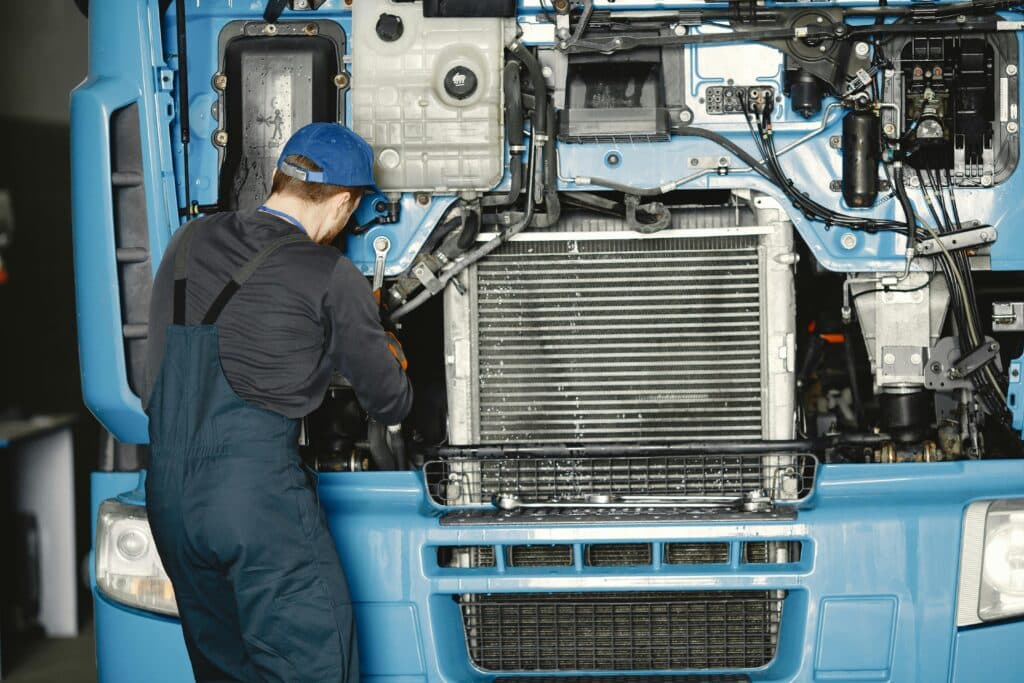In the past, routine truck inspections have been performed manually and by paper, causing delays, excessive time consumption, and data loss. The future of truck inspections is luckily moving forward in the right direction, thanks to AI and technology that is streamlining the processes.
Let’s take a look at what truck inspections entail and see how you can move through your truck inspection checklist with ease by leveraging solutions that are designed to assist.
What is Truck Inspection?
Commercial motor vehicles, like trucks in a fleet, must be inspected consistently by a qualified inspector to ensure the safety and maintenance of the vehicle. Since truck inspections are a safety matter and also regulated by government agencies (such as the Department of Transportation in America, for example) for commercial vehicles, it’s vital that the operating company takes them seriously.
Types of Truck Inspections
Truck inspections happen at different intervals and evaluate different aspects of the vehicle to make sure that everything is in good working order. Here are some examples of the various inspections that are typically required to be executed:
Pre-Trip Inspection (PTI)
As part of the pre-trip inspection checklist, there are seven items that must be checked, including: vehicle overview, engine compartment, engine startup and in-cab checks, lights, walkaround, turn signals, and LAB PS brake tests. In the event any issue is found, it must be corrected before the driver can hit the road.
Post-Trip Inspection (PTI)
Upon completion of a trip, it’s time for the post-trip inspection, which includes a review of: service brakes, steering mechanism, lighting devices and reflectors, horn, tires, windshield wipers, coupling devices, wheels and rims, emergency equipment, and rear-vision mirrors. Every vehicle that a driver has operated during the day calls for this inspection.
Periodic Inspections
Periodic inspections take place at set intervals that are laid out by state regulations. Certain parts of the vehicles must be inspected every set number of days to maintain their safety and operation.
Roadside Inspections
Roadside inspections are carried out to examine drivers, carriers and vehicles to make sure that they are complying with regulations and to capture data to know which vehicles/carriers need improvement.
Special Inspections (e.g., for hazardous materials transport)
Transporting hazardous materials comes with its own set of inspections as shippers and drivers must clearly communicate the risk and work to minimize risks associated with transporting such materials.
Components of Truck Inspection
As a company that relies on trucks or a fleet to deliver goods or services, it’s of utmost importance and value to keep all vehicles in working order. Otherwise, you are left facing delays, costs, and unsatisfied customers.
A truck inspection checklist lays out all the crucial elements that must be looked over to prevent accidents and breakdowns. This list lays out what a truck inspection will typically consist of:
Exterior Components
- Tires
- Lights
- Mirrors
- Brakes
Interior Components
- Steering Wheel
- Dashboard Gauges
- Seatbelts
Emergency Equipment
Engine and Mechanical Components
- Engine Fluids
- Exhaust System
- Transmission
- Suspension
For a single vehicle, this may be manageable, but when operating a fleet, you have to multiply the time this checklist will take by every vehicle you have. You also don’t want to be stuck with siloed data, bottlenecks, or key person dependencies. That’s where artificial intelligence and technology is changing the way truck inspections take place. We’re going to explore how in detail in the next section.
AI in Truck Inspection
Before we get to see how AI works for truck inspections, let’s define what AI is. Artificial intelligence (AI) is the application of computer systems to perform tasks that would otherwise rely on humans to complete. Machine learning complements AI by leveraging data to improve over time to mimic how human thought is carried out to make decisions.
When it comes to the business of performing a truck inspection, AI-powered inspection technologies are becoming ubiquitous. For example, computer vision is being used so that machines can “see” and pull visual data from sensors. Speech enabled-AI solutions like aiOla are empowering teams to speak through critical truck inspections in less time, with greater accuracy, in any language, accent, and acoustic environment to streamline inspection processes. aiOla allows inspectors, drivers, and maintenance crews to keep their eyes up and hands-on the vehicle, thereby preventing accidents or mistakes. Most importantly, aiOla understands business-specific jargon, which in the industry of fleet management is paramount since there are so many unique acronyms and terms in use.
Furthermore, technologies are popping up at every turn to make operations more efficient, safe, collaborative, and accurate, such as:
- Machine learning algorithms are being used to conduct predictive maintenance, meaning that companies can be proactive in repairing issues or breakdowns before they may even occur.
- AI and telematics systems are working together to provide real-time monitoring capabilities

Truck Inspection Procedures and Benefits of AI
A thorough and accurate truck inspection procedure is vital, as is the proper documentation and recordkeeping of what was performed on the vehicle. Without robust documentation, inspectors and drivers may not be aware of what is affecting a vehicle. Additionally, since truck inspections are regulated, it’s best to keep all records of maintenance and repairs to remain compliant.
When performing a truck inspection manually, paper trails can easily be lost, and it’s often hard to locate records when they are needed. Rather, companies are turning to software solutions and tools that neatly and securely store digital records, making them more accessible and collaborative.
For example, when an inspector speaks through a truck inspection using aiOla on their existing hands-free device, otherwise lost data is always captured. Additionally, should a repair or maintenance request need to be made, it can automatically be routed to the right person for the job. This way, truck inspections take less time and are completed more efficiently.
Best Practices for Truck Inspection
Looking for the best ways to ensure that your company’s truck inspection is optimized? After you’re done reading this glossary, try to keep in mind the following recommendations:
- Perform regular maintenance schedules and be proactive about repairs
- Make use of inspection checklists
- Leverage technology and speech AI
- Promote collaboration between drivers, fleet managers, and maintenance personnel
Final Words
There’s no operating fleets or commercial vehicles without performing your truck inspection in a timely manner. As such, it’s important to have the right tools by your side, along with people on your team, to ensure the safety and operation of your trucks over time.


